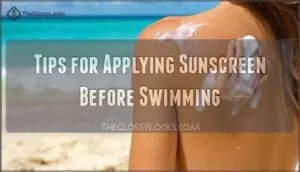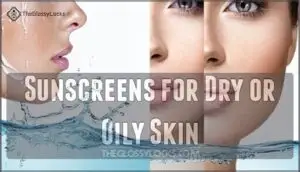This site is supported by our readers. We may earn a commission, at no cost to you, if you purchase through links.
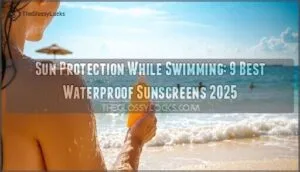
Choose a broad-spectrum sunscreen with SPF 30 or higher that’s water-resistant for 80 minutes. Apply it 15-30 minutes before entering the water, and don’t forget often-missed spots like your ears, feet, and the back of your neck.
Even waterproof formulas wash off gradually, so reapply every two hours or immediately after toweling off. The chlorine in pools and salt in seawater can break down sunscreen faster than you’d think, making regular reapplication essential for avoiding that lobster-red look.
Smart sunscreen selection and proper application techniques can make all the difference.
Table Of Contents
- Key Takeaways
- Sun Protection Basics
- Top 9 Sunscreens for Swimming
- 1. Supergoop Unseen Sunscreen SPF 40
- 2. Australian Gold Tinted Mineral Sunscreen Medium
- 3. Sun Bum SPF 50 Sunscreen
- 4. Neutrogena Beach Defense SPF 70 Sunscreen
- 5. Blue Lizard Sensitive Mineral Sunscreen
- 6. Neutrogena Ultra Sheer SPF 70 Sunscreen
- 7. Neutrogena Kids Wet Skin Sunscreen
- 8. Banana Boat Reef Friendly Sunscreen SPF 50
- 9. Hawaiian Tropic SPF 30 Twin Pack
- Sunscreen Features to Consider
- Applying Sunscreen Correctly
- Skin Types and Sunscreen
- Additional Sun Protection Tips
- Frequently Asked Questions (FAQs)
- Do you need sunscreen for swimming?
- How to choose a sunscreen for swimming?
- Can I use a mineral sunscreen while swimming?
- How do you protect your skin from sun damage?
- How do I protect my skin while swimming?
- Why is it important to protect your skin when swimming?
- Should I wear sunscreen while swimming?
- What sunscreen protects you when you are swimming?
- How to prevent tanning while swimming?
- Does wearing a shirt while swimming prevent sunburn?
- Conclusion
Key Takeaways
- You’re getting double UV exposure while swimming – Water reflects up to 15% of harmful rays back at your skin, intensifying damage beyond what you’d get on dry land.
- Choose water-resistant sunscreen with SPF 30+ that lasts 80 minutes – Apply it 15-30 minutes before entering water and don’t forget easily missed spots like your ears and neck.
- Reapply every two hours or immediately after toweling off – Even waterproof formulas wash off gradually, and chlorine and salt water break down sunscreen faster than you’d expect.
- Layer your protection with clothing and timing – Combine quality sunscreen with UV-protective swimwear and avoid peak sun hours (10am-4pm) for maximum defense against skin damage.
Sun Protection Basics
You’re exposed to intense UV rays while swimming, even when you think you’re protected by water.
Water actually reflects up to 15% of the sun’s rays back at you, doubling your exposure and increasing your risk of painful burns and long-term skin damage.
Water doesn’t protect you—it doubles your UV exposure by reflecting harmful rays straight back at your skin.
Importance of Sunscreen for Swimming
Swimming exposes your skin to intense UV rays that reflect off water, doubling your risk of sunburn.
Quality water resistant sunscreen provides essential UVB protection, preventing sunburn while reducing skin cancer risks.
Regular sunscreen application swimming helps maintain overall skin health by minimizing sun damage.
Think of sunscreen for swimmers as your invisible shield against harmful radiation, providing essential protection.
Risks of Not Wearing Sunscreen While Swimming
Without swimming sun protection, you’re gambling with your health.
Looking at the paragraph and tone, here’s a short, engaging blockquote:
**Skip sunscreen while swimming? You’re basically playing Russian roulette with your skin.
UV exposure leads to painful sunburn, premature aging, and increased skin cancer risk.
Water reflects sunlight, doubling UV intensity and damage potential.
Eye damage and immune suppression also occur.
Sunburn severity increases dramatically in aquatic environments, making protection absolutely necessary for safe swimming.
How to Choose The Right Sunscreen for Swimming
Knowing the dangers, you need smart selection criteria for swimming sun protection.
Look for broad-spectrum SPF 30+ with 80-minute water resistance.
Your skin type matters—sensitive skin needs mineral sunscreen swim options, while oily skin handles chemical formulas better.
Key factors for best swim sunscreen:
- SPF and broad-spectrum protection – blocks both UVA and UVB rays
- Water resistance duration – 80 minutes beats 40 minutes every time
- Reef-safe formulas – protects marine life without sacrificing effectiveness
- Application method – sprays work faster than thick lotions poolside
Water resistant sunscreen loses potency after labeled time limits, so reapplication isn’t optional—it’s your lifeline.
Some sunscreens offer high SPF protection against UVA and UVB rays.
Top 9 Sunscreens for Swimming
Now that you know what makes a good swimming sunscreen, let’s look at the top options that’ll keep you protected in the water.
We’ve tested and reviewed nine standout sunscreens that combine strong SPF protection with reliable water resistance, so you can focus on your swim instead of worrying about sunburn.
1. Supergoop Unseen Sunscreen SPF 40
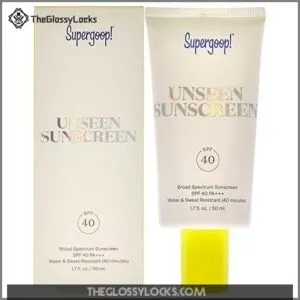
This invisible game-changer transforms your swimming routine with its weightless SPF 40 formula that won’t leave you looking like a ghost.
You’ll love how it doubles as a makeup primer while filtering blue light and UV rays for up to 40 minutes in water.
The oil-free texture absorbs instantly without that typical sunscreen smell, making it perfect for daily use.
Just remember to reapply after toweling off – your skin will thank you later.
Best For: Anyone wanting a clear, non-greasy sunscreen for daily use, makeup prep, and reliable water resistance for short swims.
- Invisible, weightless formula works for all skin tones without a white cast
- Doubles as a shine-controlling makeup primer and absorbs quickly
- No fragrance or greasy residue, ideal for oily and sensitive skin
- Loses significant SPF protection after 40 minutes in water, requiring frequent reapplication
- Higher price than many alternatives at $38 for 50 mL
- Can irritate those with highly sensitive skin or allergies to certain chemical filters
2. Australian Gold Tinted Mineral Sunscreen Medium
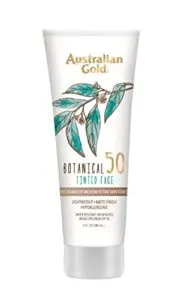
Choosing a mineral sunscreen that doubles as makeup? Australian Gold’s tinted formula delivers SPF 50 protection with 4% zinc oxide and 4% titanium dioxide.
This BB cream-style sunscreen blends seamlessly into medium to tan skin tones while providing a matte, oil-free finish.
It’s water-resistant for 80 minutes and enriched with Australian botanicals like eucalyptus and red algae.
The fragrance-free, reef-safe formula won’t clog pores, making it perfect for sensitive skin. At around $15, it’s an affordable daily choice that eliminates white cast worries.
Best For: Those with medium to tan skin tones seeking daily sun protection with a natural, matte finish and light coverage for sensitive or oily skin.
- Broad-spectrum SPF 50 with a seamless, non-greasy tint that blurs redness and evens skin tone
- Fragrance-free, reef-safe, hypoallergenic, and free of parabens, phthalates, and sulfates
- Doubles as a BB cream for easy, everyday makeup wear at an affordable price
- May transfer onto clothing and masks, requiring immediate spot treatment
- Can pill depending on skincare products used underneath and needs thorough cleansing to remove
- Not 100% "clean"—contains some additives, and shade match may not work for all skin tones
3. Sun Bum SPF 50 Sunscreen
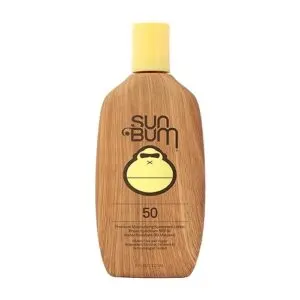
Sun Bum’s SPF 50 sunscreen delivers reliable water resistance for up to 80 minutes, making it perfect for extended swimming sessions.
This lightweight formula absorbs quickly without leaving a greasy residue, while its tropical coconut scent transports you straight to vacation mode.
You’ll appreciate that it’s reef-friendly, oxybenzone-free, and gentle enough for sensitive skin.
The broad-spectrum protection effectively blocks both UVA and UVB rays, preventing sunburn during intense outdoor activities, with broad-spectrum protection and maximum protection being key benefits, and remember to reapply every 80 minutes or after toweling off to maintain protection throughout your aquatic adventures.
Best For: Active individuals and families seeking water-resistant, reef-safe sun protection that’s gentle on sensitive skin and easy to apply.
- Lightweight, non-greasy formula with a pleasant tropical scent.
- Reef-friendly and safe for sensitive skin, complying with Hawaii Act 104.
- Broad-spectrum UVA/UVB protection and water resistance for up to 80 minutes.
- Can cause eye irritation if sprayed near the face.
- Needs frequent reapplication, especially after swimming or sweating.
- Higher price point compared to some other sunscreens.
4. Neutrogena Beach Defense SPF 70 Sunscreen
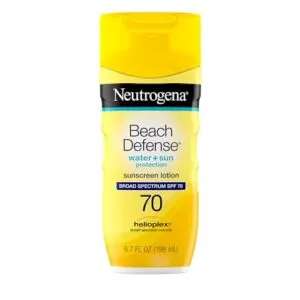
Looking for top-tier protection that won’t quit? Neutrogena Beach Defense SPF 70 delivers serious sun-blocking power with Helioplex technology, offering broad-spectrum UVA/UVB protection for up to 80 minutes in water.
This lightweight, oil-free formula absorbs quickly without leaving you looking like a ghost or feeling sticky.
It’s oxybenzone-free and PABA-free, making it reef-friendly and gentle on sensitive skin.
Perfect for fair-skinned swimmers who need bulletproof protection that actually stays put during those marathon beach sessions.
Best For: Anyone needing high-level, reliable sun protection for extended outdoor activities, especially swimmers, athletes, and those with fair or sensitive skin.
- Offers broad-spectrum SPF 70 protection that stays effective during swimming and sweating.
- Lightweight, non-greasy formula absorbs quickly and feels comfortable for daily use.
- Reef-friendly, oil-free, and suitable for sensitive or acne-prone skin.
- Needs reapplication every 80 minutes or after towel drying for continuous protection.
- May leave a slight white cast or cause flaking if overapplied.
- "Reef-safe" is based on Hawaii law, but not a standardized guarantee globally.
5. Blue Lizard Sensitive Mineral Sunscreen
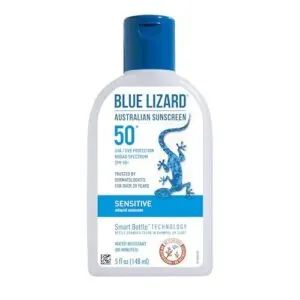
When your skin feels like it’s been through a desert storm, Blue Lizard Sensitive Mineral Sunscreen offers a gentle oasis with SPF 50 protection.
This reef-friendly formula uses zinc oxide and titanium dioxide to shield you from harmful rays for up to 80 minutes in water.
The smart bottle turns blue in sunlight—a clever reminder that UV rays are present.
Though it requires thorough rubbing and may leave a temporary white film, it absorbs well and won’t irritate sensitive skin or cause breakouts.
Best For: People with sensitive or fair skin who need reliable, water-resistant sun protection and prefer a mineral-based, fragrance-free formula.
- Strong SPF 50 broad spectrum protection with mineral actives and no harsh chemicals.
- Reef-safe, unscented, and suitable for sensitive skin without causing breakouts.
- Smart bottle cap signals UV exposure by changing color in sunlight.
- Thick texture needs thorough rubbing and may leave a temporary white cast.
- Higher price for a smaller amount compared to some other sunscreens.
- Some users report mild initial itchiness and slight milky residue on certain skin tones.
6. Neutrogena Ultra Sheer SPF 70 Sunscreen
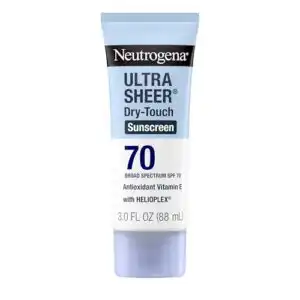
Despite countless hours spent poolside, many swimmers still struggle with sunscreen that washes off within minutes.
Neutrogena Ultra Sheer SPF 70 delivers exceptional broad-spectrum protection with Helioplex technology, shielding you from both UVA and UVB rays for up to 80 minutes in water.
The Dry-Touch formula absorbs quickly without leaving that dreaded white cast, while vitamin E provides extra antioxidant protection.
It’s oil-free, non-comedogenic, and won’t clog your pores—perfect for active swimmers who need reliable, long-lasting coverage.
Best For: Active swimmers and outdoor enthusiasts seeking high SPF, long-lasting sun protection that resists washing off.
- Water-resistant for up to 80 minutes and effective against both UVA and UVB rays.
- Absorbs quickly with a non-greasy, lightweight feel that won’t clog pores.
- Suitable for sensitive and acne-prone skin, with no added fragrance or parabens.
- May leave a white cast or residue if not fully rubbed in.
- Requires frequent reapplication, especially after swimming or sweating.
- Occasional separation of ingredients in high heat, needing vigorous shaking before use.
7. Neutrogena Kids Wet Skin Sunscreen
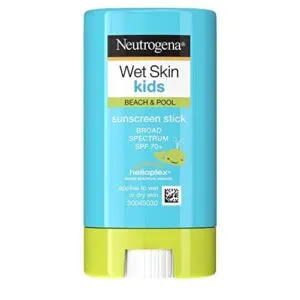
Pool-side chaos with squirmy kids? Neutrogena’s Kids Wet Skin Sunscreen transforms sunscreen battles into breeze-through moments.
This SPF 70+ powerhouse applies directly to wet or dry skin, cutting through water instantly with Helioplex technology.
It’s dermatologist-tested, hypoallergenic, and PABA-free—perfect for sensitive young skin.
The 80-minute water resistance keeps active swimmers protected, while its clear, non-greasy formula won’t sting eyes or leave white streaks.
Parents love the stick format for quick touch-ups, and the fact that it’s a powerhouse that makes sunscreen application easy.
Best For: Families with active kids who need fast, reliable sunscreen protection that works on wet or dry skin.
- Applies clearly to wet or dry skin, making pool or beach reapplication easy.
- Hypoallergenic, PABA-free, and non-greasy—safe for sensitive skin and won’t sting eyes.
- Convenient stick format offers hands-free, mess-free use and works well on the go.
- Smaller stick size means more frequent repurchasing, especially for daily use.
- More expensive than many other stick sunscreens available.
- Primarily designed for face and small areas, not full-body coverage.
8. Banana Boat Reef Friendly Sunscreen SPF 50
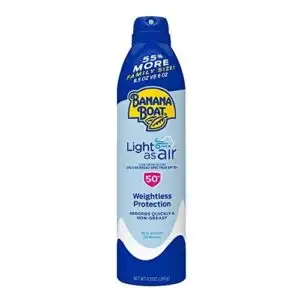
Choosing sunscreen that won’t harm coral reefs feels like threading a needle, but Banana Boat’s SPF 50 spray makes it easier.
This lightweight formula absorbs quickly without leaving you feeling greasy, and it’s water-resistant for 80 minutes. You’ll appreciate how it doesn’t sting your eyes when you’re sweating.
However, despite being labeled "reef friendly," it contains avobenzone and octocrylene—ingredients some marine biologists link to coral damage.
For true reef protection, check local regulations before your beach vacation.
Best For: People who want lightweight, non-greasy sun protection with broad spectrum coverage and water resistance for outdoor activities.
- Absorbs quickly and doesn’t leave a sticky or oily residue
- Water resistant for up to 80 minutes and easy to apply
- Doesn’t sting eyes or irritate skin, even when sweating
- Contains avobenzone and octocrylene, which may harm marine life despite "reef friendly" labeling
- Bottle is prone to dents during shipping and may stain fabrics if not fully absorbed
- "Reef friendly" claims are controversial and may not meet all local regulations
9. Hawaiian Tropic SPF 30 Twin Pack
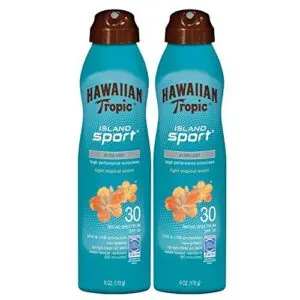
Getting two bottles for the price of one makes Hawaiian Tropic’s SPF 30 twin pack a budget-friendly choice for active swimmers.
This lightweight, fast-absorbing formula provides broad-spectrum protection and stays put for 80 minutes in water.
You’ll love the signature tropical scent that won’t overpower your senses.
The chemical sunscreen blends seamlessly into all skin tones without leaving white streaks, and it’s oxybenzone-free and reef-friendly, so you can protect both your skin and marine life during your swimming adventures.
Best For: Active swimmers and outdoor enthusiasts who want lightweight, water-resistant sun protection with a pleasant scent.
- Broad-spectrum UVA/UVB protection with an ultra-light, fast-absorbing formula.
- Water and sweat resistant for up to 80 minutes, ideal for swimming and sports.
- Reef-friendly and cruelty-free, with a signature tropical scent.
- Higher price compared to other sunscreens in the same category.
- No return policy for defective bottles.
- Subtle sheen finish may not suit those who prefer a matte look.
Sunscreen Features to Consider
When you’re shopping for swimming sunscreen, you’ll want to focus on three key features that make all the difference between getting fried like a lobster and staying protected.
Look for water resistance ratings (40-80 minutes), reef-friendly formulas, and dermatologist-tested options that won’t irritate your skin during those long pool days.
Water Resistance and SPF Level
When swimming, water resistance and SPF level determine your sunscreen’s effectiveness.
Look for "water-resistant" labels indicating 40 or 80 minutes of protection—not truly waterproof despite marketing claims.
SPF 30 blocks 97% of UVB rays, while SPF 50 blocks 98%. Higher isn’t always better; reapplication frequency matters more than chasing SPF 100.
Choose broad spectrum formulas for complete sun protection during your swim. Consider browsing options for best water resistant sunscreens to find the right fit.
Reef-Friendly and Non-Nano Ingredients
Beyond SPF ratings, ingredient safety matters for both you and marine ecosystems.
Reef safe sunscreen with nonnano zinc oxide or titanium dioxide protects coral reefs from harmful chemicals like oxybenzone and octinoxate.
These mineral sunscreen options offer superior environmental impact protection while providing effective UV coverage.
Non-nano zinc particles are larger, ensuring they reflect UV rays effectively.
Nano-particle concerns include marine absorption, making nonnano formulas the smarter choice for conscious swimmers, as they provide a safer alternative and support marine conservation.
Hypoallergenic and Dermatologist-Tested Options
Sensitive skin requires special attention when selecting sunscreen for swimming.
Dermatologist-tested formulas minimize allergy concerns through rigorous ingredient research, making them safer for pediatric use and eczema sufferers.
- Fragrance-free formulas reduce irritation risk for sensitive skin types
- Mineral-based options with zinc oxide offer gentler protection than chemical alternatives
- Hypoallergenic labels indicate products tested to minimize allergic reactions
- Pediatric-approved sunscreens undergo additional safety testing for children’s delicate skin
Applying Sunscreen Correctly
Having the right sunscreen won’t help if you don’t apply it correctly – even the best waterproof formula can fail when put on wrong.
You’ll need to master the timing, technique, and frequency of application to stay protected during your swim sessions.
How Often to Reapply Sunscreen While Swimming
You’ll need to reapply sunscreen every two hours, but swimming changes the game.
Water-resistant formulas protect for 40-80 minutes in water, then lose effectiveness.
Always reapply immediately after swimming, sweating heavily, or toweling off.
Activity intensity and skin sensitivity affect reapplication frequency—active swimmers need more frequent touch-ups than casual floaters, and this is influenced by swimming and skin sensitivity.
Tips for Applying Sunscreen Before Swimming
Perfect timing application is essential for effective sun protection.
Apply sunscreen 15-30 minutes before hitting the water, allowing it to bind with your skin.
Use generous amounts – about one ounce for your entire body.
Don’t forget hard-to-reach spots like your back and behind your ears.
Always apply to dry skin first for maximum water resistance during your pre-swim routine.
Common Mistakes to Avoid When Applying Sunscreen
Don’t fall into these sunscreen traps that can leave you burned. Using an insufficient amount is like painting a fence with a tiny brush—you need one ounce for your entire body.
Missed spots around your hairline and behind your ears create painful reminders later. Check expiration dates because expired sunscreen loses its protective power.
Wrong timing matters too—apply 15-30 minutes before swimming so it bonds with your skin. Remember to think about broad-spectrum protection for full defense against UVA and UVB rays.
Ignoring ears and other forgotten areas turns proper sunscreen application into a sunburn disaster. It is crucial to consider broad-spectrum protection and apply sunscreen correctly to avoid a painful reminder and ensure full defense.
Skin Types and Sunscreen
Your skin type affects how sunscreen performs and what protection level you need.
Fair skin burns quickly and needs higher SPF, while darker skin tones have more natural protection but still require broad-spectrum coverage.
Sunscreens for Dry or Oily Skin
Your skin type matters when choosing sunscreen for swimming.
Dry Skin Sunscreens with hydrating ingredients like glycerin and shea butter replenish moisture lost in water.
Oily Skin Sunscreens feature Non-Comedogenic Options and Mattifying Formulas that won’t clog pores.
Hydrating Sunscreens work best for dry skin, while gel-based formulas control shine for oily skin types.
Selecting the right sunscreen can be easy with specialized dry sunscreen.
Sunscreens for Fair or Dark Skin
Your skin tone determines which sunscreen formula works best for swimming adventures. Fair Skin Needs higher SPF levels and frequent reapplication since less melanin means faster sunburn risk. Dark Skin Needs broad spectrum protection too—melanin provides some natural defense but won’t prevent all UV damage during extended water exposure.
Selecting sunscreen with appropriate SPF level is essential for both skin types.
- Choose mineral sunscreens with zinc oxide for fair skin’s sensitive nature
- Look for chemical formulas to avoid White Cast Issues on darker complexions
- Fair skin burns in 10-15 minutes without protection; dark skin takes longer but still needs coverage
- Melanin Protection varies by individual—everyone benefits from water resistance during swimming
- Tanning Differences don’t eliminate cancer risk; use sun protection regardless of skin tone
Additional Sun Protection Tips
Even with the best waterproof sunscreen, you’ll need extra protection for those long pool days or beach adventures.
Smart swimmers know that sunscreen works best when paired with other sun-smart strategies that keep you covered from sunrise to sunset.
Wearing Protective Clothing While Swimming
UPF Swimwear offers the ultimate defense against harmful rays while you’re splashing around. Unlike sunscreen that washes off, sun protection swimwear maintains consistent coverage.
Swim shirts, rash guards, and swim leggings block 98% of UV rays with UPF 50+ ratings. Prolonged sun exposure can lead to weakened and brittle hair, so scalp protection is also important.
| Garment Type | Coverage Area | UPF Rating |
|---|---|---|
| Long Sleeve Swim Shirt | Arms, torso, shoulders | UPF 50+ |
| Rash Guard Swimming | Core, back, chest | UPF 50+ |
| Swim Leggings | Legs, thighs | UPF 50+ |
| Sun Hats | Face, scalp, neck | UPF 50+ |
| UV Protection Clothing | Full body options | UPF 50+ |
Sun protective swimwear eliminates missed spots that sunscreen often leaves behind.
Seeking Shade and Avoiding Peak Sun Hours
Peak Sun Avoidance becomes your best friend when you’re planning pool time.
The sun’s UV rays hit hardest between 10 AM and 4 PM, making early morning or late afternoon your safest Swimming Schedule options.
Even on cloudy days, UV rays penetrate Cloud Cover, so don’t skip sun protection.
Check the UV Index before heading out—anything above 6 means extra caution.
Shade Structure Types like umbrellas or pavilions provide relief, but remember: water reflects UV rays, increasing sun exposure even under cover.
Using Sunscreen in Combination With Other Protective Measures
Sunscreen’s your swimming buddy, but it works best with backup. Smart timing beats slathering on SPF 100 and hoping for the best.
Here’s your sun protection toolkit:
- Clothing and Sunscreen: UPF rashguards plus waterproof sunscreen create double defense
- Shade and Sunscreen: Duck under umbrellas between swims for skin recovery time
- Timing and Sunscreen: Avoid 10am-4pm peak hours when UV rays hit hardest
- Hydration and Sunscreen: Drink water to prevent dehydration that weakens skin’s natural protection
Reapplication strategies matter most during sunsafe swimming—your water resistance clock starts ticking the moment you jump in.
Frequently Asked Questions (FAQs)
Do you need sunscreen for swimming?
Yes, you definitely need sunscreen for swimming.
Water reflects up to 10% of UV rays, intensifying sun exposure.
You’ll still get burned underwater since UV rays penetrate water.
Choose water-resistant SPF 30+ that lasts 80 minutes.
How to choose a sunscreen for swimming?
Choose SPF 30+ broad-spectrum sunscreen that’s water-resistant for 80 minutes. Look for reef-safe formulas without oxybenzone. Mineral sunscreens work immediately, while chemical ones need 15-minute absorption time.
Can I use a mineral sunscreen while swimming?
Mineral sunscreen is swimming’s ultimate superhero, offering rock-solid protection with zinc oxide and titanium dioxide.
You’ll get broad-spectrum coverage that works immediately upon application, making it perfect for water activities and sensitive skin with broad-spectrum coverage.
How do you protect your skin from sun damage?
Stay protected by wearing broad-spectrum sunscreen with SPF 30+, reapplying every two hours. Seek shade during peak sun hours (10am-4pm), wear protective clothing, and don’t forget sunglasses for your eyes.
How do I protect my skin while swimming?
Like a fish needs water, you need SPF 30+ water-resistant sunscreen. Apply 15 minutes before swimming, reapply every 80 minutes. Choose reef-safe formulas with zinc oxide for lasting protection.
Why is it important to protect your skin when swimming?
Swimming exposes your skin to harmful UV rays that reflect off water, intensifying damage. You’ll face increased risk of sunburn, premature aging, and skin cancer without proper protection.
Should I wear sunscreen while swimming?
Yes, you should definitely wear sunscreen while swimming. Water reflects UV rays, intensifying sun exposure by up to 15%. Choose water-resistant formulas with SPF 30+ that last 80 minutes for maximum protection.
What sunscreen protects you when you are swimming?
Water-resistant sunscreen with SPF 30-50 protects you best while swimming. Choose broad-spectrum formulas lasting 80 minutes in water, like Neutrogena Beach Defense or Sun Bum Original, and reapply frequently.
How to prevent tanning while swimming?
Apply broad-spectrum SPF 30+ sunscreen 15 minutes before swimming, reapply every 80 minutes. Choose water-resistant formulas with zinc oxide. Wear UV-protective clothing, wide-brimmed hats, and seek shade when possible.
Does wearing a shirt while swimming prevent sunburn?
A shirt provides some sun protection while swimming, but it won’t completely prevent sunburn.
Regular cotton blocks about 5-15% of UV rays, while wet fabric offers even less protection.
You’ll still need waterproof sunscreen underneath for adequate coverage.
Conclusion
Research shows that 90% of skin cancer cases are linked to UV exposure, making proper sun protection while swimming absolutely essential for your health.
You’ve now got the knowledge to choose the right waterproof sunscreen and apply it correctly.
Remember, water amplifies UV rays, so don’t skip the reapplication every two hours.
Whether you’re pool-side or beach-bound, combining quality sunscreen with protective clothing and shade creates your best defense against harmful radiation.
Your skin will thank you later.



